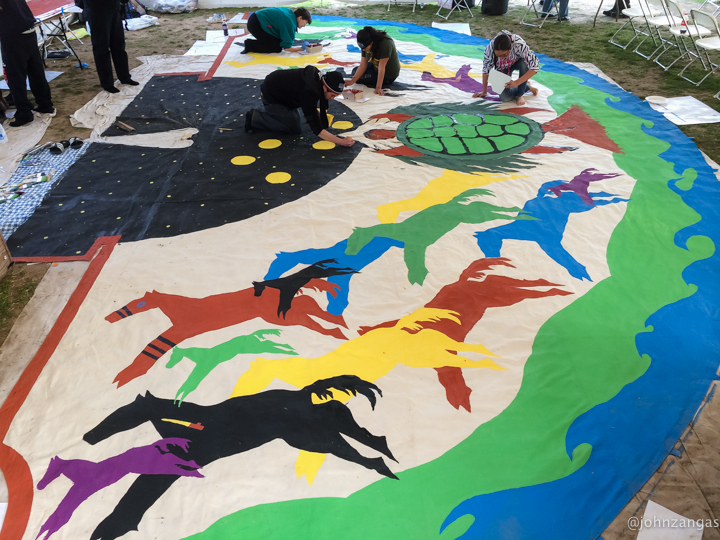 They say that the longest journey begins with one step. The Great March for Climate Action took its first steps on March 1 in Los Angeles. By November 1, when the marchers arrive at the White House, they will have taken over 15 million steps.
They say that the longest journey begins with one step. The Great March for Climate Action took its first steps on March 1 in Los Angeles. By November 1, when the marchers arrive at the White House, they will have taken over 15 million steps.
Thirty-four people started in Port of Wilmington in Los Angeles and will have walked over 3,000 miles in eight months when they finally reach Washington, D.C. Even the wagon trains of the 1800’s took less time to cross the country.
Along the way, they have stopped in major cities and small communities, bringing attention to the effects of climate change and the global need to transition from fossil fuels to renewable energy.
The arrival of the Great March for Climate Action in Washington, DC kicks off a week of actions called Beyond Extreme Energy(BXE) planned forNovember 1-7. A coalition of over 50 groups is mobilizing against fossil fuel destruction of the environment. Every weekday morning they plan to block the entrance to the Federal Energy Regulatory Commission (FERC). Hundreds are expected to join the Great March for Climate Action on Saturday, November 1 as it proceeds to its final destination, the White House.
A Life-Changing Experience
When the original thirty-four people started walking from Port of Wilmington, Los Angeles, they had no idea that walking across the country would turn into a life-changing experience. Traversing major cities, hiking the Appalachians, trekking the Plains, and crossing the proposed KXL pipeline route gave them eight months to consider their purpose for marching. Walking 3,000 miles has been cathartic for all of them.
During the first weeks of the March, they learned to overcome the physical challenges of walking 15-25 miles a day–8 to 10 hours each day, resting one day a week. The core group stayed together from the beginning; not one person dropped out, according to Jimmy Betts, an organizer and participant. He attributed the no-attrition rate to a “strong community spirit” and a team of six with medical backgrounds and holistic healing.
Environmental Destruction, a Warning to All of Us
Jerry Stewart, 27, from Virginia, taught English in China. “I don’t regard myself as an environmentalist, or even a climate activist,” he said by email. “Instead, I think of myself as a person trying to find a sane response to the radical actions of the fossil fuel industry and their protectors in government, willing as they are to lay waste to the planet for their bottom line.”
Stewart was teaching English in Guangzhouwhen at a vocational college when he began “experiencing the destruction of the Earth’s ecosystems in such a palpable way. ” He said he bears witness the same climate change factors happening in Virginia and “felt compelled to get more involved.”
The Great March has taught him the importance of community living as an effective means to change the system under which we operate. “We need to overturn our current system of deregulated corporate capitalism if we are to stand a chance,” he said.
Coming to Terms With a Dying Environment
Sean Glenn, 22, from Connecticut is marching as a project to complete her last credits in Theater Education at Emerson College. She was inspired by Thich Nhat Hanh to find her center while reflecting on the 200 species going extinct every day. “I couldn’t wait to connect with those who would feel the same sorrow I do in terms of what we are doing as a species to ourselves and all other life,” she said by email.
Glenn vowed silence during the march, remaining mute for 109 days. “I could be present and listen to all those who have important things to say… listen to the birds, the wind in the trees, the cars zooming by, the songs of all my friends,” she said.
By the time Glenn spoke, she had come to a life-altering realization. “I know now that marches are not going to save us. I still struggle with this desire to save humanity though I’m not sure if that is our natural course,” she said. “All things must come to an end. We humans are no exception from the rule. I just hope we come to ours with grace.”
But Glenn remains positive about the possibility to change. “Enough has been said…we don’t have any more time for words, right now we need action!”
A Mother Teaches Earth’s Lessons to Her Children
Dana McGuire, a mother of four, has been a climate activist for two years and walked long distances before with her children. Her previous marches helped prepare her for the Great Climate March. Based on studies that she has read, she believes it is already too late to undo the damage already done to the climate. “As I march and share my climate perspective, I am planting seeds, some of which will later sprout into curiosity, learning, understanding, acceptance,” she said by email.
She said she feels a need to come to terms with the damage done to the environment and grieve its irrevocable loss. McGuire believes marching has been a personal way for her to come to terms with it. “Marching for climate is an embodiment of grief. It is a way to use our bodies and our voices to navigate the ‘negotiation/ bargaining’ stage of the grief process,” she said.
“Yes, sure, we might yet devise a planetary-scale technological response…some geo-engineering strategy for saving something of what we inherited,” she said. “But the technology does not yet exist, and the many experiments and designs which have been in development do not yet offer us any concrete hope. So sure, patience is good and hope is fine. But let us also acknowledge what is.”
Reinstating the Power of the People
Betts, one of the key organizers of the march, also teaches traditional healing arts, body therapies, and martial arts. He sees the march as more than “simply walking across the country.” For him, “deciding to participate in the march was a creative way of broadening collaboration and impact.”
On the march, he has visited “disproportionately affected communities” which, he says, “need more than a voice: they require and demand justice of an ecological magnitude.” That’s why he sees “reinstating the power of the people… over state and federal governance” as key.
“Our entire planet is a climate-impacted area,” said Betts.
Support Behind the Scenes
The March has relied on thousands of supporting fans to help them. Ki Coulson, its Communications Director based in Los Angeles, said the biggest challenge was raising the funds they needed, nearly $8,000 per month. At times, their funds “fell nearly to nothing,” she said. Each person was tasked with raising $20 per day, but marching and raising funds proved to be difficult while on the road. There were times organizers nearly had to call off the march, but at the last minute they managed to scrape together the money.
Final Push to the White House
The Great March for Climate Action arrives in Bethesda, MD on October 30. On Saturday, November 1, they will make the final seven-mile push to the White House. Hundreds are expected to accompany them.
During the week of November 3-7, the Beyond Extreme Energy coalition will conduct a civil disobedience action every morning at the Federal Energy Regulatory Commission (FERC). FERC is the agency responsible for permitting interstate natural gas pipelines and LNG terminals which contribute to climate change. Plans forSunday, November 2 include free classes and trainings on civil disobedience at St. Stephens Church to prepare for the upcoming week.
The public is invited to walk with them on the last leg into DC and attend a 1:30 pm assembly at Lafayette Square, across from the White House.





